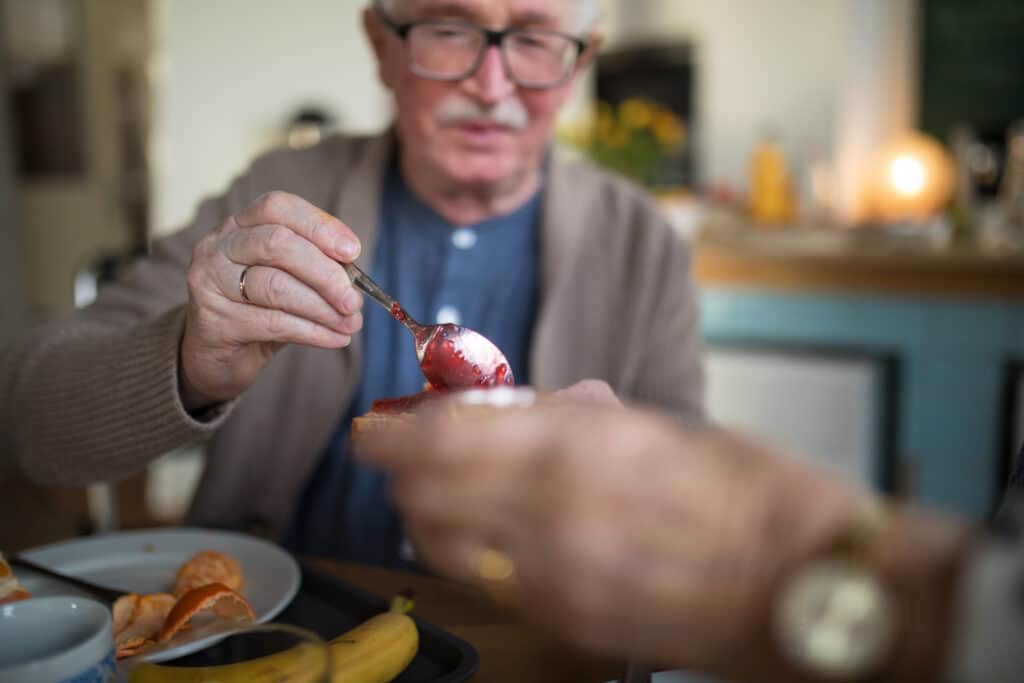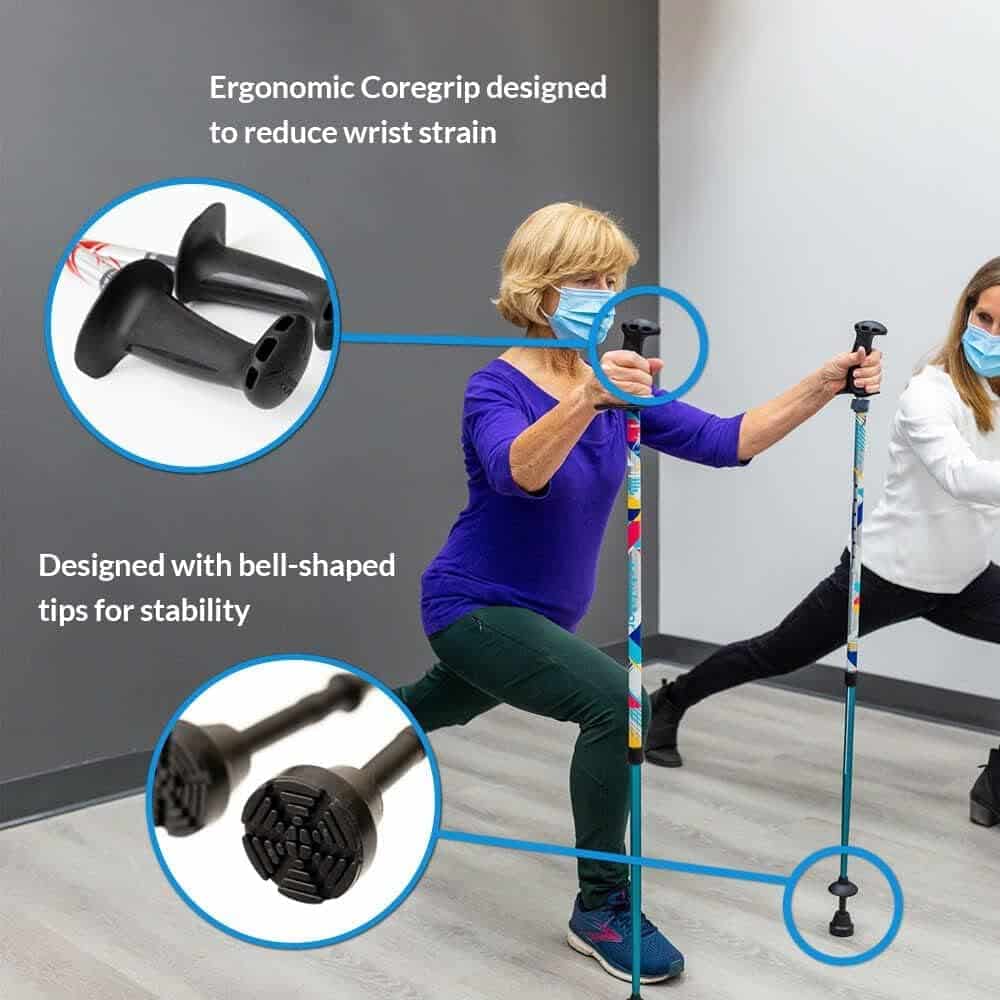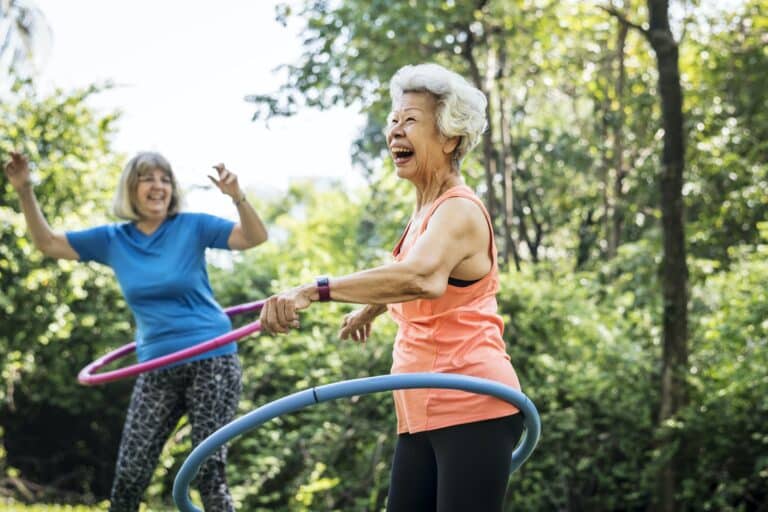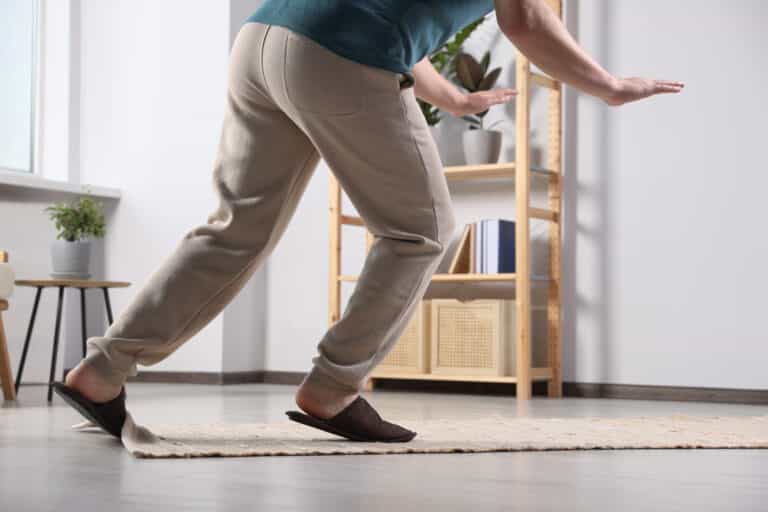Navigating life with Parkinson’s Disease (PD) presents a unique set of challenges, from managing motor symptoms like tremors and rigidity to coping with cognitive and emotional changes. Fortunately, Parkinson’s Disease assistive tools offer advantages, providing simple solutions to common problems for those affected by PD.
This article explores the many benefits of these tools, ranging from devices that enhance mobility and fine motor skills to technologies that support cognitive functions and emotional well-being. I’ll provide clinical insights about how these tools have impacted my patients’ lives and how they might do the same for you.
By taking advantage of these assistive tools, people with Parkinson’s can improve their quality of life through simple changes to make daily tasks easier.
Whether aiding with mobility, supporting fine motor skills, or managing cognitive challenges, the thoughtful integration of assistive tools offers simple solutions and a higher quality of life at any stage.
The Benefits of Parkinson’s Disease Assistive Tools
If you’ve received a Parkinson’s diagnosis, you might find that it can sometimes feel as though you simply cannot function as you used to. You may feel too reliant on others, and losing independence can be frustrating. But that doesn’t always have to be the case.
While there is currently no cure for PD, there are a variety of ways to slow the progression of the disease. There are also many tools available to make navigating a Parkinson’s diagnosis easier.
Assistive tools can significantly enhance PD patients’ overall well-being and daily functioning. They serve as valuable allies in bypassing obstacles and fostering independence in basic activities of daily living, such as eating, walking, and maintaining fine motor skills.
Promoting Independence and Mental Health
Independence is important for older people, both with and without Parkinson’s. Tackling daily challenges becomes pivotal for preserving autonomy.
Social and emotional well-being are also closely tied to independently managing daily challenges. Successfully navigating them enables patients to engage more fully with their communities and maintain positive mental health.
By addressing specific problems associated with Parkinson’s, these tools empower individuals to navigate many aspects of their daily lives more comfortably, safely and efficiently.
A Guide to Tools for Parkinson’s Motor Skill Impairments

Motor skill impairments, particularly in upper extremity fine motor skills and upright mobility, pose significant difficulties for older adults with Parkinson’s.
These seemingly drastic changes can be challenging, affecting the ability to perform routine, daily activities like walking short distances, standing unsupported, or even simple tasks like buttoning a shirt or eating dinner.
Assistive Tools for Fine Motor Skills
Fine motor skills involve coordinating small muscle movements, usually synchronizing one’s hands and fingers with their eyes. As Parkinson’s progresses, these skills can become increasingly more challenging.
In my years of practice, I’ve seen patients struggle even with seemingly mundane tasks, like picking up a pill from the table, brushing their teeth, or changing the channels on the television. This difficulty may be attributed to “pill-rolling” tremors, bradykinesia, and decreased dexterity associated with PD.
Here are a few ways to use adaptive equipment to help with fine motor tasks:
Assistive Utensils
A common complaint from my patients with Parkinson’s is their ability to eat using normal utensils—forks, knives, and spoons are tricky to grip and maneuver from the dinner plate to their mouths.
Adaptive utensils and dinnerware can be game-changing. Specially designed tools make eating more manageable, allowing individuals to maintain independence and enjoy meals without frustration.
An example of this is the swivel spoon. This innovative spoon features a swiveling mechanism in the handle, allowing the bowl of the spoon to remain level regardless of the user’s hand movements or tremors. This practical and ergonomic design helps individuals with limited dexterity or hand coordination to eat more independently.1
Special Supplies Adaptive Utensils 4-Piece Kitchen Set
As we’ve noted with other eating utensils for Parkinson’s, added weight is your friend. It helps to balance out the tool and give you better control.
Special Supplies Adaptive Utensils 4-Piece Kitchen Set have an additional feature we like: they are bendable. You can customize your cutlery to the perfect angle for your grip and eating style.
For someone with Parkinson’s, this means that not only do you have the weighted stability and the non-slip grip, but you also have the ability to bend the utensils to suit your specific needs. It’s about adapting the tool to fit you, not the other way around.
Our recommendations are the same items we trust and prescribe to patients. When you buy through links like this on our site, we may earn an affiliate commission to support new content.
Assistive Digital Technology
Limited manual dexterity can also hinder the use of traditional electronic devices such as smartphones and tablets. That’s where voice-activated devices (smart speakers, home automation) can help.
Individuals can control their environment and devices using voice commands without relying on manual interactions. Now that technology is becoming more accessibility-friendly, settings within your smartphone can allow you to control everything you would typically do by touch, by voice instead.
Perhaps voice-interactive technology isn’t your thing, but you still want the experience of using smart technology. In that case, you can use phones, tablets, and remotes with larger buttons or fonts.
This larger surface area to click facilitates easier interaction by accommodating motor skill or coordination difficulties, making communication more accessible.
Assistive Devices for Parkinson’s Disease Mobility Challenges

Another common issue is the difficulty in upright mobility, such as walking, stair climbing, and getting in and out of a car.
Parkinson’s Disease is known to make even walking short distances and standing upright difficult. As a physical therapist who frequently sees PD patients, I’ve witnessed these mobility issues’ impact on an individual’s quality of life.
Unfortunately, approximately 60% of people with PD fall at least once a year, with two-thirds of these individuals experiencing recurrent falls.2
These statistics underscore the importance of addressing and managing mobility challenges to prevent accidents and maintain independence.
Helpful Tools for Walking and Mobility
There are many devices that physical therapists may recommend for someone struggling specifically with their motor and mobility skills due to Parkinson’s. The first is a walking aid or assistive device.
Walking aids such as canes, walkers, and rollators provide additional support and stability, helping individuals navigate their surroundings with a reduced risk of falls. They can increase an patient’s support base, improve balance, and keep them on their feet.
URBAN POLING Activator® Poles
Many of our Parkinson’s patients like to use walking poles for added security during exercise. The type of poles you use definitely makes a difference. Urban Poling Activator Poles are our #1 recommendation. Urban Poling ACTIVATOR Poles were designed by an occupational therapist & gerontologist specifically for rehab and long-term conditions. The smart design enhances strengthening, stability and off-loading with your safety in mind. These are the right support tool while challenging yourself through a Parkinson’s exercise program.
Our recommendations are the same items we trust and prescribe to patients. When you buy through links like this on our site, we may earn an affiliate commission to support new content.
Other Functional Orthopedic Tools for Balance and Coordination
Parkinson’s can also directly impact motor skills and muscle rigidity, which can cause deficits in limb position and posture.
Braces & Orthotics
Appropriately prescribed and fitted braces and orthotic devices can stabilize affected limbs, promote better balance and posture, and reduce the risk of falls.
These braces and orthotic devices can and should be tailored to individual needs, ensuring a personalized approach to address specific challenges. This customization enhances their effectiveness in providing support and improving mobility.
Orthofeet Slip-On Shoes
It’s easy to find slip-on shoes in any mall, right? The problem is they usually lack the support and stability we need. Orthofeet specializes in orthotics first, and then builds the shoe around them. Shoes like the Orthofeet Yari are ideal to add stability to a shuffling gait, for instance. They have a large selection of styles available, so you don’t feel you are getting stuck with whatever happens to be in stock. Along with many other physical therapists, we find it to be our favorite online source for patients not needing support and stability but not custom orthotics.
Our recommendations are the same items we trust and prescribe to patients. When you buy through links like this on our site, we may earn an affiliate commission to support new content.
Specialized Shoes
Though you may not think of shoes as an assistive device, they can aid in the safety and balance of those with existing impairments.
Impaired balance due to PD can require footwear that promotes stability and proper traction. Shoes with non-slip soles are recommended to enhance strength and reduce the risk of slipping, supporting safe mobility.
Having a supportive pair of tennis shoes that are easy to put on and take off can also help promote more independence for people with PD.
Managing Non-Motor Symptoms of Parkinson’s Disease

While motor symptoms are often the focus of PD treatment since they are most apparent to the naked eye, it’s crucial not to overlook the non-motor symptoms associated with Parkinson’s that affect cognitive abilities and emotional well-being.
Here are some options to consider for non-motor impairments from PD:
Helpful Tools to Aid with Cognitive Challenges
Cognitive impairments can range from mild forgetfulness to severe dementia, and these are not uncommon in older adults. In the PD community, cognitive issues are a significant concern, with around 40% of PD patients experiencing some form of cognitive impairment.3
I encourage my patients to maintain a daily routine, use reminders or alarms for tasks, and engage in cognitive-stimulating activities. It’s about finding the best way to maintain your cognitive health as it applies to your specific condition.
In addition to these mindful tasks, additional assistive devices may be recommended to keep you on track.
Tools to Improve Routines and Monitoring
Parkinson’s often requires strict adherence to a medication schedule. However, it also impacts memory and cognition, creating challenges to staying on schedule with medicine.
Automated pill dispensers exist that ensure timely and correct medication dosage, reducing the likelihood of missed or incorrect doses.
Cognitive impairments can also result in those with Parkinson’s forgetting to use the mobility devices that were recommended to them in the first place to help with balance and prevent falls.
Movement alarms for beds and chairs may be helpful in cases of severe impairment. These alarms alert caregivers when an individual attempts to get up from their current location. Caregivers can respond appropriately, reducing the risk of falls and ensuring timely assistance.
This allows caregivers more freedom to tend to their needs, knowing that their loved one is safe and sound if the alarm is not going off.
Tools for Emotional Wellbeing
Lastly, it’s important to touch on the emotional and mental toll of Parkinson’s.
Aging and related health conditions can already take a toll on one’s mental health. Depression, anxiety, and apathy are common in older adults, especially those with PD.4
Remember, it’s okay to seek help. Numerous resources, such as counseling or therapy, are available for mental health support. Taking care of your mental health is as important as your physical health.
Routines for Better Emotional Health
A structured routine can provide a sense of predictability, reducing stress and anxiety. Assistive devices that help maintain a routine, such as alarms or reminders, contribute to emotional stability.
And setting alarms or reminders to perform specific mindfulness activities or meditation can help even more.
Maintaining Social Ties with Communication Aids
Staying connected with friends and family can provide emotional support and reduce feelings of isolation and loneliness. Devices like large-button phones or voice-activated devices make communication more accessible.
Access to these devices can also help access mental health resources online. These include support groups, counseling services, and educational materials promoting emotional resilience.
Navigating through the challenges of PD can be tricky. Still, it can be managed effectively with the proper support and strategies, and Parkinson’s Disease assistive tools can help
Summary
Our exploration of Parkinson’s Disease (PD) has unveiled the potential of assistive tools in transforming the lives of those affected. From devices that ease the difficulties of mobility and fine motor skills to technologies that support cognitive health and emotional resilience, they are testaments to human ingenuity and compassion.
In exploring the various challenges and solutions, it’s clear that living with Parkinson’s can still mean a life full of independence, fulfillment, and participation. The future shines brighter with each advancement in assistive technology, promising a landscape where Parkinson’s does not dictate limits but presents opportunities for adaptation and growth. This narrative is not just about managing symptoms—it’s about enhancing the quality of life for individuals and their caregivers, creating a hopeful outlook for everyone touched by Parkinson’s Disease.
Key Takeaways
- Parkinson’s Disease (PD) presents unique challenges, including motor and non-motor symptoms that impact daily living.
- Assistive tools play a crucial role in enhancing the quality of life for individuals with PD, offering practical solutions to overcome these challenges.
- Innovations in mobility aids, such as walkers and adaptive footwear, provide stability and reduce the risk of falls, promoting independence in movement.
- Adaptive utensils and voice-activated technologies facilitate everyday activities, helping individuals with PD maintain autonomy in tasks like eating and using digital devices.
- Cognitive aids, including automated pill dispensers and reminder systems, support memory and routine management, which are crucial for medication adherence and daily organization.
- Emotional well-being is supported through assistive devices that enable social connectivity and access to mental health resources, mitigating feelings of isolation.
- Integrating assistive tools into the lives of those with PD addresses physical and cognitive challenges and fosters a sense of empowerment and participation.
- The evolving assistive technology landscape holds promise for an even brighter future for individuals living with Parkinson’s Disease, emphasizing innovation and hope.
References
- Jansa, J., & Aragon, A. (2015). Living with Parkinson’s and the emerging role of occupational therapy. Parkinson’s Disease, 2015.
- Pickering, R. M., Grimbergen, Y. A., Rigney, U., Ashburn, A., Mazibrada, G., Wood, B., … & Bloem, B. R. (2007). A meta‐analysis of six prospective studies of falling in Parkinson’s disease. Movement Disorders, 22(13), 1892-1900.
- Janvin, C. C., Larsen, J. P., Aarsland, D., & Hugdahl, K. (2006). Subtypes of mild cognitive impairment in Parkinson’s disease: progression to dementia. Movement disorders: official journal of the Movement Disorder Society, 21(9), 1343-1349.
- Schrag, A., & Taddei, R. N. (2017). Depression and anxiety in Parkinson’s disease. International review of neurobiology, 133, 623-655.









